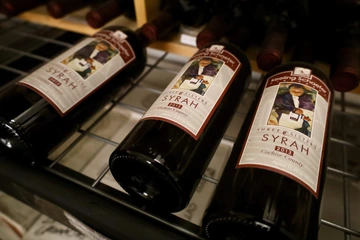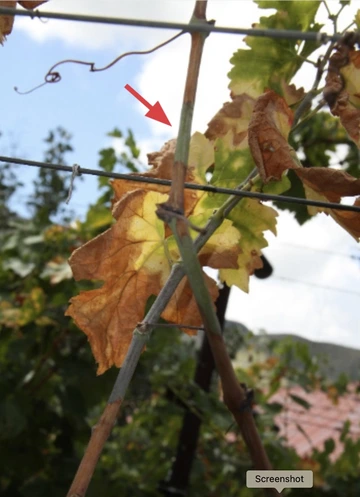Extension helps wine growers identify, deal with disease, pests and weather threats
A recent symposium highlighted several ways University of Arizona scientists and other experts are helping the state's expanding industry thrive amid threats from weather, pests and diseases.

This fan at Keeling Schaefer Vineyards in Cochise County will kick in when temperatures get below freezing. The air movement prevents frost in the vineyard.
Brad Poole, Cooperative Extension
Weather took a few swings at Arizona vineyards in 2023 – including a spring freeze and a hot, dry summer – but overall, it will be a good year statewide for the wine industry, a former president of the Arizona Wine Growers Association said at a recent industry gathering presented by University of Arizona Cooperative Extension.
“The fruit quality was good, and the wine quality is going to be very good,” said Rod Keeling, owner of Keeling Schaefer Vineyards in Pearce.
Keeling was one of about three dozen industry stakeholders at Extension’s 2023 Viticulture Winter Symposium at the UArizona Controlled Environment Agriculture Center, where scientists, vineyard operators and others compared notes, traded information and took a look back at the growing season.

The wine "library" at Keeling Shaefer Vineyard includes every vintage they have nproduced.
“This workshop today, in my view, had the most intellectual horsepower of any workshop I’ve ever attended at the University of Arizona or at any of the conferences I’ve gone to. We had some serious scientists in here today,” Keeling said.
Yavapai County Extension Director Matt Halldorson organized the meeting with Extension climate and geospatial scientist Jeremy Weiss, Ph.D., both of whom have worked since 2022 to build a UArizona-based support network of experts.
“The goal is to be an unbiased source of information in viticulture,” Halldorson said.
Extension’s help for the wine growers includes weather data, information on grape disease, pest and soil management, and gatherings that bring science directly to the industry.
Climate Impact
Weather was the biggest threat Arizona vintners faced in 2023. A hard freeze April 4 hit some growers just before buds were about to emerge, causing a delay, but the slow start didn’t stop canopies – the leafy, treelike tops of the plants – from developing at his Cochise County vineyards, Keeling said.
“Once it got going, it came out pretty quick. It really took off,” he said.
Later, a hot dry summer plagued many growers. The heat helped control insect pests, but it threatened canopies at some vineyards. Above about 95 degrees, the pores on the leaves close, and photosynthesis shuts down.
On many days this summer that was half the day, said Jim Graham of Golden Rule Vineyards in Cochise County.
“That kind of explained why there was slow development from July through August,” he said.
Sonoita, which got more rain and saw lower temperatures than the state’s other two growing areas, had a banner year, said Kent Callaghan of Callaghan Vineyards.
“It was pretty much picture perfect for the first time in many, many years,” he said.
Weather monitoring is a vital part of the industry.
Weiss, who manages the Arizona Meteorological Network, a series of 30 weather stations across Arizona, has been collecting and analyzing climate data to identify conditions that led to success or failure.
“Once we start to get more information about what the problems are, then we can get more specific about the solutions ... Our conceptual models are working pretty well, now as we get more information, we can figure out solutions,” Weiss said.
Pests and Diseases
Extension plant pathologist Alex Hu, Ph.D., gave an update on three important grapevine diseases, including the emerging threat red blotch, endemic diseases such as Pierce’s disease, and grapevine trunk diseases. Red blotch, which is caused by a virus, was identified in 2005 in California and first found in Arizona in 2021. Hu checked 13 Arizona vineyards this year and found red blotch at almost all of them. Testing is important to keep this virus contained, Hu said.
“If you want to test for specific diseases, let me know,” he said.

Pierce's disease, which id carried by insects, is a common problem for wine growers.
Alex Hu
Bugs were not a serious threat in Arizona this year, but there are emerging threats to watch, said Extension entomologist Shaku Nair, Ph.D.
She offered an overview of vineyard insects, some of which attack vines and some of which carry diseases, like sharpshooters, which were first identified in Arizona at a Sierra Vista vineyard in 2005.
Some insects, such as mealybugs, are a threat to Washington vineyards but not yet in Arizona. The insect carries the virus which causes leaf roll, a grape disease that is not common here, Halldorson said.
“Just because it isn’t here yet, doesn’t mean you shouldn’t be aware of it,” he told the gathering.
Identifying insects is vital, because growers can waste money spraying for the wrong insects. Growers who need identification of insects should contact Nair, she said.
Soil and Irrigation
Debankur Sanyal, Ph.D., an Extension soil health specialist, told symposium attendees that soil for grape vines is more difficult to manage than other crops, because the plants remain year after year while other crops, like cotton or spinach, are replaced annually.
Ultimately choosing tools to build soil health starts with one question for commercial operations, he said.
“Can we make money out of it, either short term or long term? If I don’t have that confidence, then I don’t really delve into that method,” Sanyal said.
Irrigation was the top concern in a needs assessment survey Extension completed last year.
Arizona’s soil variability makes one-size-fits-all irrigation difficult, said plant physiologist Robert Wample, Ph.D., a symposium attendee who saw wide soil variation in Google Earth photos of Arizona vineyards.
“It’s a huge challenge,” said Wample, a professor emeritus in the Fresno State University Department of Viticulture and Enology who now works with a company that offers soil analysis to wine growers.
Soil analysis can inform irrigation choices. Not analyzing soil beforehand can leave a grower “stuck” with the wrong irrigation system on part or all of a vineyard, he said.
Chad Preston, co-founder of Birds & Barrels Vineyards considered the symposium a good chance to compare notes and confirm or disprove current methods.
“Sometimes you think you’re doing something well, but you could always be doing it better,” Preston said.

